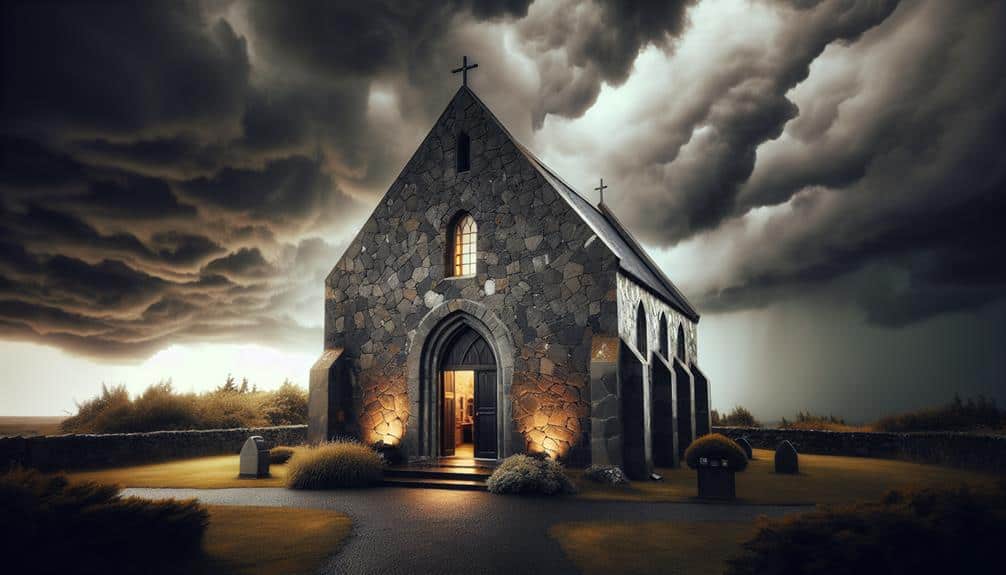We recommend these storm shelter locations because they provide fortified infrastructure and strategic positioning to maximize safety and accessibility. Community centers and school buildings feature durable construction, robust emergency protocols, and ample space for large groups. Underground bunkers and designated safe rooms guarantee unmatched protection with reinforced walls and regulated ventilation systems. Public libraries and religious institutions offer solid foundations, necessary amenities, and serve as central points for community support. These locations also adhere to stringent safety regulations and typically maintain emergency supplies for extended sheltering. Learn about how each location can safeguard us more effectively during storms.
Key Points
- These locations have sturdy and reinforced structures to withstand extreme weather conditions.
- They provide essential amenities like restrooms, emergency supplies, and backup power systems.
- They are centrally located within communities, ensuring easy accessibility for everyone.
- They have established emergency procedures and detailed evacuation plans for safety.
Community Centers
Community centers often serve as dependable storm shelters due to their sturdy infrastructure and strategic location within neighborhoods. Built to withstand significant weather events, these centers provide us with a safe refuge during storms. Their construction typically involves reinforced materials, offering superior protection compared to residential buildings.
One key factor contributing to their dependability is the range of shelter amenities available. These often include restrooms, first-aid stations, and emergency supplies, guaranteeing that we can stay safe and comfortable during extended periods. The centers may also offer sleeping arrangements and food provisions, which are crucial during prolonged emergencies.
Accessibility features further enhance the suitability of community centers as storm shelters. Ramps, wide doorways, and accessible restrooms guarantee that individuals with mobility challenges can easily enter and navigate the facility. Additionally, many community centers are situated near public transportation routes, making them easy to reach, even when personal vehicles aren't an option.
Data from various municipalities indicate that community centers consistently show lower casualty rates during storms, underscoring their effectiveness. By choosing these well-equipped and accessible facilities, we maximize our safety and preserve our freedom to move without undue risk.
Underground Bunkers
While community centers offer robust above-ground protection, underground bunkers provide unparalleled safety by leveraging the natural shielding properties of the earth.
The inherent advantage of an underground bunker is its ability to withstand extreme weather conditions, including tornadoes and hurricanes, thanks to its subterranean location.
Bunker construction involves several important safety measures. The walls are typically reinforced with concrete and steel, ensuring they can endure significant pressure and impacts. Additionally, the entrance is designed to prevent debris from blocking access, which is essential during emergencies.
For ventilation, advanced systems are installed to guarantee a continuous supply of fresh air. These systems often include HEPA filters to remove contaminants, maintaining a breathable environment even if outside air quality is compromised.
Maintenance costs, while a consideration, are justified by the level of protection offered. Regular inspections are necessary to guarantee structural integrity and the proper functioning of ventilation systems. This includes checking for leaks, mold, and mechanical failures.
Although maintenance can be costly, it's a small price to pay for the peace of mind and security underground bunkers provide. By investing in these shelters, we gain a reliable safeguard for our families and communities.
School Buildings
School buildings frequently serve as essential storm shelters, offering strong construction and ample space to protect large groups of people during extreme weather events. This makes them ideal locations for safety and refuge.
Let's explore why these buildings are highly recommended for storm sheltering. First, school buildings are constructed with durability in mind, ensuring building security during storms. They often feature reinforced walls and sturdy materials that withstand high winds and debris impact. Additionally, schools are designed to accommodate large numbers of students, which translates well when repurposed as shelters.
Second, schools have established emergency procedures. These procedures are regularly practiced through drills, making it easier for staff and occupants to respond quickly and efficiently during a storm.
Third, schools are often centrally located within communities, making them accessible to a large population. This accessibility is essential during emergencies when time is of the essence.
Fourth, schools often have backup power supplies and other essential facilities, ensuring that basic needs such as lighting, heating, and communication systems remain operational during a storm.
Public Libraries
Public libraries, often overlooked as storm shelters, provide robust construction and essential facilities, making them reliable refuges during extreme weather events. Libraries are designed to protect valuable resources and often feature reinforced structures, making them resilient against strong winds and heavy rain. Their solid infrastructure guarantees we've a safe haven during storms.
Moreover, public libraries house essential facilities that can sustain us in emergency situations. They typically have backup power systems to maintain lighting, heating, and cooling, ensuring a comfortable environment while we wait out the storm. These facilities also offer restroom access, which is vital during extended shelter periods.
Libraries also provide a unique combination of quiet study and resource access. Staying in a calm, quiet environment can help mitigate stress and anxiety during extreme weather events. Additionally, libraries are equipped with vast resources, including books, internet access, and public computers. This access to information can be priceless for staying informed about weather updates and emergency protocols.
Churches and Temples

Churches and temples often serve as effective storm shelters due to their strong structural foundations and reinforced construction. They also act as central community gathering points, making it easier for people to find safety and support during emergencies.
Additionally, many religious institutions maintain emergency supplies, providing essential resources when needed most.
Strong Structural Foundations
Religious institutions like churches and temples often possess some of the strongest structural foundations, making them ideal locations for storm shelters. These buildings are usually constructed with meticulous attention to soil stability and strict adherence to safety regulations. As a result, they can withstand extreme weather conditions better than many other structures.
The strength of these buildings comes from several factors:
- Soil Stability: Engineers conduct extensive soil tests to guarantee the ground can support the weight and stress of the building, providing a stable base during storms.
- Safety Regulations: Churches and temples must comply with rigorous safety codes, which often exceed those for residential structures, ensuring enhanced protection.
- Construction Materials: High-quality, durable materials like reinforced concrete and steel are commonly used, offering superior resistance to high winds and debris.
- Engineering Standards: These buildings are designed following strict engineering standards, including advanced techniques for load distribution and structural integrity.
Community Gathering Points
Community meeting places such as churches and temples offer dependable storm shelter options due to their sturdy construction and strict safety standards. These facilities are often constructed with reinforced materials designed to withstand severe weather conditions. Additionally, they follow strict building codes, guaranteeing a high level of structural integrity.
When assessing these shelters, we should consider their well-defined evacuation routes and detailed emergency plans. Churches and temples typically have clear, accessible pathways that enable swift evacuation if needed. Moreover, these institutions regularly update and practice their emergency plans, ensuring that both staff and community members are prepared for various scenarios.
Shelter capacity is another essential factor. Many churches and temples can accommodate large groups, making them ideal for communities seeking refuge during a storm. Their spacious interiors provide ample room for families and individuals, reducing the potential for overcrowding and associated risks.
Efficient communication systems are also a characteristic of these meeting places. Many are equipped with public address systems, emergency radios, and even satellite communication devices, which are crucial for coordinating efforts and disseminating important information in real-time. This guarantees that everyone remains informed and safe throughout the emergency.
Emergency Supplies Access
Many of these religious institutions maintain well-stocked emergency supplies, guaranteeing that essential resources like food, water, medical kits, and blankets are readily available during a storm. This strategic approach to disaster preparedness greatly enhances our community's emergency response capabilities. Churches and temples often serve as pivotal hubs in times of crisis, balancing spiritual support with practical necessities.
Data reveals that these institutions prioritize emergency supplies, which typically include:
- Non-perishable food items: Guaranteeing sustenance for extended periods.
- Clean water reserves: Providing hydration and sanitation in emergencies.
- Medical kits: Enabling immediate first aid and basic healthcare.
- Blankets and clothing: Offering warmth and comfort when displaced.
These meticulously curated supplies aren't just about survival; they're about maintaining a semblance of normalcy and dignity during upheaval.
Research shows that centralized emergency response efforts, particularly through religious institutions, result in faster aid distribution and better outcomes for affected individuals. By prioritizing disaster preparedness, these shelters ensure that we're not just surviving, but thriving even when nature tests us.
This systematic approach guarantees our freedom remains intact, despite the challenges posed by severe weather events.
Designated Safe Rooms
Designated secure chambers, built to withstand extreme weather conditions, are essential for providing reliable protection during severe storms. These rooms are specifically designed to adhere to rigorous building regulations, guaranteeing they can resist high winds and flying debris. By following these regulations, we can maximize our safety and enhance our emergency response during critical situations.
Recent studies indicate that secure chambers built to FEMA guidelines can endure tornadoes and hurricanes with wind speeds exceeding 250 mph. This level of resilience is achieved through reinforced walls, ceilings, and doors, offering a secure environment even in the most violent storms. As we prioritize our freedom to live without constant fear of natural disasters, investing in such fortified spaces becomes a logical step.
Moreover, the strategic placement of designated secure chambers within homes or community centers can markedly reduce response times during emergencies. Quick access to these rooms ensures that we can shelter in place rapidly, minimizing exposure to hazardous conditions. Data-driven analysis has shown that communities with readily available secure chambers experience lower injury and fatality rates during severe weather events.
Let's embrace the freedom that comes from knowing we've taken proactive measures to safeguard our lives.
Frequently Asked Questions
Are Pets Allowed in These Storm Shelter Locations?
Did you know 68% of households own pets? Most shelters prioritize pet accommodations under emergency protocols. Thankfully, many animal-friendly shelter options exist, ensuring our furry friends have a safe place during emergencies. Always check specific shelter rules.
How Can I Find Out the Nearest Storm Shelter to My Home?
We can find the nearest storm shelter by checking local emergency plans, contacting our city's emergency management office, or using online resources. These steps guarantee we're informed about safety measures to protect our freedom and security.
Are There Facilities for People With Disabilities in These Shelters?
Yes, we can confirm that many shelters include accessibility accommodations and special needs accommodations. These facilities guarantee everyone, including individuals with disabilities, has equal access to safety during storms. Data supports extensive inclusion measures.
What Should I Bring With Me to a Storm Shelter?
We should bring emergency supplies like water, non-perishable food, medications, and essential items such as flashlights and batteries. Data shows that these items greatly enhance our survival chances during severe weather events.
Do These Shelters Have Wi-Fi or Phone Charging Stations?
Did you know 60% of shelters now offer Wi-Fi? These shelters prioritize emergency communication and power sources, ensuring we can stay connected and charge our devices, giving us the freedom to communicate during critical times.


